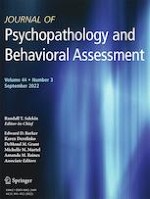02-03-2022
A Measurement Model of Media Parenting: Differences Across Parent and Child Reports and Youth Age and Sex
Gepubliceerd in: Journal of Psychopathology and Behavioral Assessment | Uitgave 3/2022
Log in om toegang te krijgenAbstract
For youth raised in the Digital Age, online risks such as cyberbullying and sexting have become increasingly problematic. Since digital media is primarily consumed at home, parents play an important role in mitigating these risks; parents can teach children about online dangers, regulate the amount of time spent online, and, to some extent, curate the online content children see. The present study evaluated the psychometric properties of a four-factor media parenting measurement model introduced by Livingstone et al. (2011) across self-reports of a U.S. sample of parents (Mage = 38.5) and children (ages 10–14; Mage = 11.8). To identify meaningful group differences, latent mean comparisons were evaluated across youth age and gender. Confirmatory Factor Analysis results provided good fit to the data for the four-factor media parenting model based on both parent [χ2(201, n = 306) = 384.407; RMSEA(.046—.063) = .055; CFI = .958; TLI/NNFI = .951; SRMR = .050] and child report [χ2(203, n = 306) = 378.033; RMSEA(.045-.061) = .053; CFI = .942; TLI/NNFI = .934; SRMR = .060]. The final latent parenting factors included: Active Mediation, Monitoring, Technology Control, and Restrictive Mediation. Latent mean comparisons revealed that parents of girls reported higher levels of Monitoring than parents of boys, whereas girls reported higher levels of parental Restriction than boys. Similarly, older children and their parents reported lower Restriction than younger children and their parents. Overall, latent mean differences identified between media parenting domains may be important for youth outcomes and provide support for their inclusion as distinct factors in predictive models.
